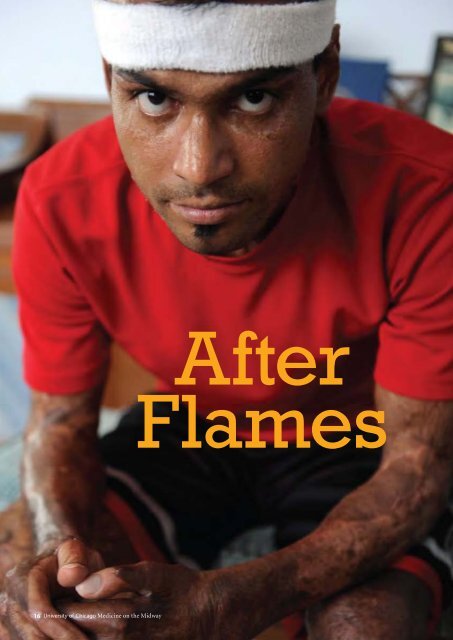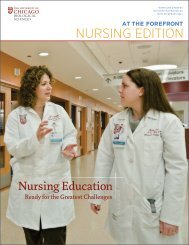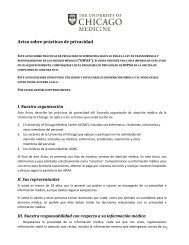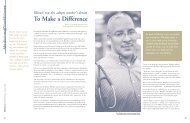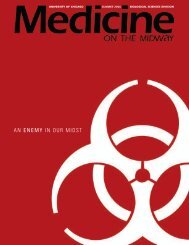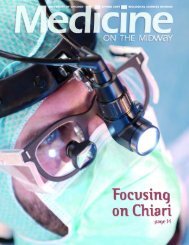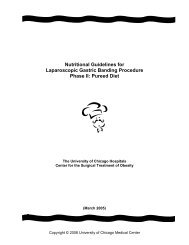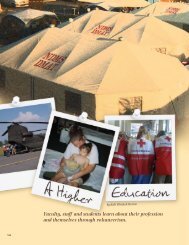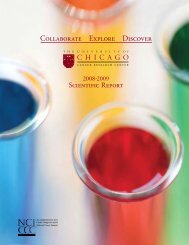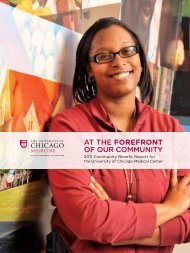After Flames
Fall 2009: After Flames - University of Chicago Hospitals
Fall 2009: After Flames - University of Chicago Hospitals
- No tags were found...
You also want an ePaper? Increase the reach of your titles
YUMPU automatically turns print PDFs into web optimized ePapers that Google loves.
<strong>After</strong><strong>Flames</strong>16 University of Chicago Medicine on the Midway
With 95 percent of his body surface burned,Manoj Rana survived through sheer determination andthe dedication of his skilled Medical Center team.By Susan Chandler and Philippe Taponn the night of July 1, 2005,Steven Craig Allen and his wife weredrinking in their ground-floor apartmenton Tanglewood Drive in Hammond,Ind. Allen was reportedly upset becausehe couldn’t go to Florida with his girlfriendwho was heading south the nextday, and he was ready for a break. He had been saddled withchildcare duties for his three-month-old daughter since his wifehad returned to work a month earlier. Around 4 a.m. on July 2,Allen walked around the apartment spreading gasoline. Then heignited the fuel and ran outside to watch the blaze.Three floors above, Manoj Rana and his roommate PrabhatSinghal were asleep. Both were engineering students. Rana wasfrom Noida, a suburb south of Delhi, and Singhal was fromAligarh, 82 miles from Delhi. Both were finishing their degreesat Purdue University Calumet in Hammond. As tourists, theyhad seen the skyscrapers and the Cloud Gate sculpture inMillennium Park, and were told about how the grid pattern ofthe city had been made possible by the Chicago Fire.Rana and Singhal had gone to bed late, having returned froma birthday party that had started at midnight in accordancewith Indian tradition. Singhal was sleeping on a couch next tothe balcony window. The heat of the flames woke Singhal and hewoke Rana and called 911. By then, black suffocating smoke hadengulfed the staircases, and the balcony outside their slidingglassdoor was on fire.The apartment was getting hotter and smokier, making itdifficult to breathe. Singhal had already made two 911 calls andrealized that it was going to be a while before the fire departmentwould arrive. He called a close friend and begged him toplease come soon and save him and Rana: “We are going to die.Rana remembers being put onto a gurney. He remembersthe paramedic saying, “This guy doesn’t have a chance.” Theparamedic could have said that about Singhal, who wouldn’tsurvive the blaze. Singhal was dead—wet in the bathtub, wherehe had taken refuge from the heat and smoke. Rana was firsttaken to St. Margaret Mercy where physicians determined he hadbeen burned over 95 percent of his body surface, not countingthe burn in his lungs. He needed to be transferred to a burn center.Rana remembers the paramedic saying,“This guy doesn’t have a chance.”There are three burn centers in the Chicago area: StrogerHospital, Loyola University Medical Center, and the Universityof Chicago Medical Center. In Illinois, the Medical Center andLoyola are the only two facilities that have been verified by theAmerican Burn Association as providing optimal care for burnvictims from injury through rehabilitation.At the Medical Center, the Burn Center Director is LawrenceJ. Gottlieb, MD, a plastic surgeon. Plastic surgery, in the days of“nip/tuck,” has a somewhat mercenary reputation. But Gottliebis uninterested in patients who want facelifts, tummy tucks, andBotox. He prefers to see the patients who have no faces, or nothroats, or no hands, or who have been hurt so grievously no oneelse will take them—the patient who “doesn’t have a chance.”A lot can happen in 10 minutes.An egg, for example, can be cookedin about three minutes.We are going to die,” Singhal repeated into the phone. Rana ranfor it, charging bare-footed down a staircase poised above thefire. The staircase collapsed, and Rana was stuck in the fire forabout 10 minutes.A lot can happen in 10 minutes. An egg, for example, can becooked in about three minutes. It can be hard-boiled in aboutseven minutes. The temperature in the downstairs apartmentwas at least 1,100 degrees Fahrenheit, because the aluminum inthe kitchen pots melted. Where Rana lay, the temperature wasmuch cooler, perhaps somewhere between 300 and 600 degrees.Left: Manoj Rana, 26, four years after the fire that burned 95 percent of hisbody surface. Photo by Dan Dry. Right: Rana in the operating room beingtreated while warmed with lights.Fall 2009 17
Burn Center Director Lawrence J. Gottlieb, MD, pictured above in the burn unit, wasRana’s surgeon. In all, Rana had 35 operations at the Medical Center. Photo by Bart HarrisThe emergency doctors at St. Margaret’s called Gottlieb.They explained that this guy was a “John Doe . . . inhalationinjury . . . house fire . . . 95 percent.” Gottlieb said: “Yes. We havea bed. We’ll take him.”The helicopter ride aboard the university’s UCAN helicopter,took nearly 12 minutes but it cost roughly $8,000. Ranahad student insurance, excellent for vaccinations, check-ups oreven broken bones. The maximum expense was an impressivesounding$100,000. But Rana’s care went through that moneyin a matter of days.He was admitted to room D-201 in the University of ChicagoBurn Center. Rana’s skin was coming off in shreds, like a costumecoming apart at the seams. Machines were breathing forhim, collecting his urine, watching his heart. Working closelywith Gottlieb, anesthesiologist and intensive care specialistAvery Tung, MD, along with anesthesia resident Rishi Taneja,MD, and surgery resident Ariel Spencer, MD, guided Ranathrough those first harrowing 16 days, which included eighttrips to the operating room. Assisting them was a multidisciplinaryteam of nurses, nutritionists and therapists.“God has put some wonderful people inRana’s path up there at the University ofChicago Medical Center.” John Burke,Lake County Deputy ProsecutorBurn wounds look simple, but burn patients suffer in waysthat seem quite mysterious. As the burned lie in their beds,they consume vast amounts of calories while they rebuild tissue—5,000a day—comparable to what long-distance cyclistsexpend. And yet they do nothing but breathe. The patients canstarve without moving a muscle.Because burn patients leak huge volumes of fluids from theirwounds, they need tremendous amounts of intravenous fluids.But pumping in all that liquid can kill if it builds up in a patient’slungs, causing them to essentially drown in their own fluids.Given the extent of Rana’s burns, Tung and Gottlieb knewthat managing his fluid levels was going to be crucial. Theydecided to try something controversial—infusing Rana rightaway with albumin, a protein solution derived from blood,which leaks out slower than simple saline solution. Most burnpatients aren’t treated with albumin until later for fear that leakingprotein would worsen fluid buildup in the lungs and tissues.But Tung and Gottlieb sensed that slowing fluid leakage in Ranawas the top priority.“It was so successful we now routinely resuscitate this wayfor major burns,” Tung said.As the team worked frantically, some good news emerged.Under ashes and blood, physicians found that 10 percent ofRana’s skin had been spared, mostly near his groin, on hisscalp and also a little on his back. The skin from the few placesthat had not been burned was allowed to regrow, and was thenharvested again, and again. Burned skin was cut off and replacedwith temporary grafts of pig or cadaver skin, each lasting foronly a few weeks.During Rana’s first month, he needed dressing changes twicea day and dozens of surgeries. Not surgery to make him lookpretty—surgery to save his life by removing dead skin beforeit could become infected and cause sepsis. Each surgery was atremendous challenge, requiring careful choreography just totransport Rana to the operating room, which had to be heatedto 85 degrees to keep him warm. In all, Rana had 35 operationsat the Medical Center.While the physicians and nurses were fighting to save Rana’slife, a hospital social worker, Pamela Oberlie, was battling forhim on other fronts. She worked to extend Rana’s student visaand helped him successfully appeal his initial Medicaid denial.That effort was critical because without a successful appeal,Rana would have been repatriated to India after he was stabilizedand likely wouldn’t have survived.Eventually, a Medicaid reimbursement came in for about$1.3 million, but Rana’s care at the Medical Center totalednearly $5 million. An additional $700,000 in physician chargeswere written off.18 For more information, call 1-888-UCH-0200 or visit uchospitals.edu
Rana’s brother Deepak requestedleave from his university in Indiaand flew over to keep vigil in hisolder brother’s room. Deepak couldspeak no English. Rana could notspeak at all because he was in a comaand remained unconscious for fourmonths. Ronald McDonald House, setup to provide free lodging to parentsof children who were ill, graciouslyoffered Deepak a place to stay.There is an old burn unit yarn thataround Christmas patients act up.And although Rana was Hindu, atthe winter solstice, he had his darkestdays. <strong>After</strong> five months of keepingmostly clear of infections, he becameseptic as bacteria moved into hisbloodstream. The bacteria seemed toresist everything, and Rana came evencloser to dying than he had been thenight of the fire. For a few tense daysit looked like all the months of workhad been for nothing. But, again, hemade a hair’s breadth escape. Somedrugs finally kicked in, bacteria waskilled and his blood became clean.That was the turning point. FromDecember onward, it was clear to themedical team he was going to live.In 2006, Rana got better, stronger. He opened his eyes, hestarted to move. He made what physicians call in their restrainedlanguage “a remarkable recovery.”With 95 percent of his skin grown back, he was transferrednot to India—there would be no hospital to take him there—but to the acute rehabilitation program at Wishard MemorialHospital in Indianapolis. There, he met Shannon Hendricks,an occupational therapist, who could see that under his scarswas a man who wanted to be rehabilitated. Eventually, Rana wasdischarged to a nursing home where he lived day by day, sharingrooms with people who were dying or suffering from dementia.Under the influence of daily morphine to control pain, helearned again how to stand and walk. <strong>After</strong> a year, he was able tostart bringing a spoon to his mouth.At the time of the fire, Rana was one course shy of completinga degree in computer engineering at Purdue University. The lastrequirement was waived, and Rana was able to put on a gown,stand up, walk, and receive his engineering degree. His momflew in for his graduation.Rana suffered a fourth-degree burn to his heel, down to histendons and bones, and had several toes amputated on his leftfoot. These were his only amputations: Gottlieb and his medicalteam had spared every other digit. Hendricks, who had seenRana completed a half-marathon May 3, 2008 inIndianapolis, just a week after a surgery that left incisionsin both shoulders. His occupational therapist, ShannonHendricks, is running next to him. Photo provided byManoj Ranamany tough scrapes, but nothing astough as this, coached him to walkfaster and faster—and then to run.With Hendricks running and sometimeswalking alongside him everystep of the way, Rana completed ahalf marathon in the summer heat ofIndianapolis in 2008. He managedto run 13.1 miles, even though hisgrafted skin had no sweat glands. Hedid this a week after a surgery thatleft eight-inch incisions on both hisshoulders. He returned to a nursinghome that he increasingly was outgrowing,and was discharged to liveon his own.Rana is now working on his MBAfrom the Kelley School of Business atIndiana University in Indianapolis.In his most recent accounting course,he got the top grade in his class.In March, Steven Allen was foundguilty of three counts of murderand two counts of arson. On June25, 2009, Rana and Hendricks wentto Allen’s court sentencing. Beforehe handed down his sentence,Lake County Superior Court JudgeClarence Murray said that Rana wasan inspiration and a “testament tothe ability of the human spirit to persevere in the face of greatadversity.” Then he pronounced Allen’s sentence: 220 years—60 years each for the murder of Allen’s wife, daughter andSinghal, plus 40 years for the aggravated arson that left Rana soseverely injured.Lake County Deputy Prosecutor John Burke, who handledthe Allen case and has gotten to know Rana over the past fewyears, called him “a great kid” and in an ironic way, a lucky one.“God has put some wonderful people in Rana’s path up there atthe University of Chicago Medical Center,” Burke said.Allen is appealing his conviction. In April, Judge Murrayapproved Allen’s request to marry the girlfriend whose Floridatrip set the stage for the tragedy. The marriage has sincetaken place.Rana has decided to remain in America. He is currently hereunder a U visa, which grants temporary legal status and work eligibilityto victims of crimes. Eventually, he would like to obtaina green card, which would make him a permanent legal resident.He has stated, “I came to America to have a better education anda better life so I could provide for my family.” With the surgeriesbehind him, Rana can at last begin reconstructing, not the betterlife he had imagined, but the best life he can have.Fall 2009 19


